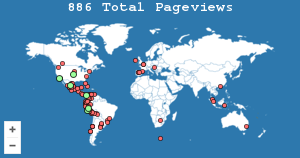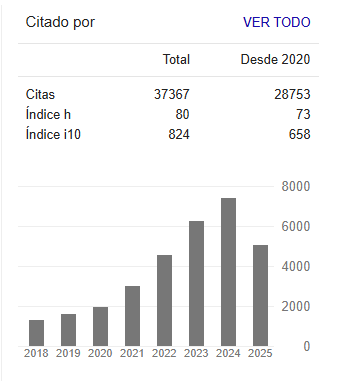Organizational management of communication in Social Responsibility: an indicator of media literacy in managers
Resumen
The research analyzes the interactions of users with regard to content administrated and published by Spain’s Government to promote media literacy and combat misinformation, and its implications for similar actions in the management of organizations which might be tasked with these very mission. To meet this objective, all the tweets issued by the official profile of this institution (4938) were collected and those that dealt with any of the following categories were selected: COVID-19, Restrictions, Vaccines, and Fake News. An analysis of the descriptive statistics of the possible interactions on Twitter was carried out, that is likes, comments and retweets. Similarly, an analysis of the means of the variances was carried out to observe if there were significant differences between and within the groups. The content generated is shared more because it is a public institution of reference, but to a much lesser extent in the case of fake news. Even more illuminating is the mostly negative feeling generated in the comments.
Citas
Abuín Vences, N. (2014). Las estrategias publicitarias de los anunciantes españoles en los Social Media. El caso de Facebook. Revista Internacional de Investigación en Comunicación aDResearch, 9(9), 65-75.
Aladro Vico, E. (2020). Comunicación sostenible y sociedad 2.0: Particularidades en una relación de tres décadas. Revista de Comunicación de la SEECI, 24(53), 37-51. https://doi.org/10.15198/seeci.2020.53.37-51
Almeida, A. S. (2020). Adoctrinar con la palabra: prensa y propaganda nacionalsocialista en las islas Canarias durante la Guerra Civil. Historia y Comunicación Social, 25(2), 379-388. https://doi.org/10.5209/hics.72270
Barquero Cabrero, M., Rodríguez Terceño, J., & Gonzálvez Vallés, J. E. Tecnologías de la comunicación y posverdad: Implicaciones para la gestión de la comunicación hospitalaria. Revista de Comunicación y Salud, 8(1), 85-97. https://doi.org/10.35669/revistadecomunicacionysalud.2018.8(1),85-97
Barrientos-Báez, A., Barquero Cabrero, M., & García García, E. (2018). Posverdad y comunicación 2.0. Revista de Ciencias de la Comunicación e Información, 23(1), 43-52. https://doi.org/10.35742/rcci.2018.23(1).43-52
Bazaco, Á., Redondo, M. y Sánchez-García, P. (2019). El clickbait como estrategia del periodismo viral: concepto y metodología. Revista Latina de Comunicación Social, 74, 94-115. http://doi.org/10.4185/RLCS-2019-1323
Bhaskara, S., & Bawa, K. S. (2021). Societal Digital Platforms for Sustainability: Agriculture. Sustainability, 13(9), 5048.
Buendía, L., Colás, P., & Hernández, F. (1998). Métodos de Investigación en Psicopedagogía. McGraw-Hill.
Caldevilla-Domínguez, D., & Xifra, J. (2013). Historia de los Lobbies: una forma de escribir la historia. Historia y Comunicación Social, 18, 879-892. https://doi.org/10.5209/rev_HICS.2013.v18.44371
Caldevilla-Domínguez, D., Barrientos-Báez, A., & Fombona-Cadavieco, J. (2020). Evolución de las Relaciones Públicas en España. Profesional de la Información, 29(3), 1-28. https://doi.org/10.3145/epi.2020.may.05
Cappello, G. (2017). Literacy, Media Literacy and Social Change. Where Do We Go From Now?. Italian Journal of Sociology of Education, 9(1), 31-44.
Carrera, P. (2018). Estratagemas de la posverdad. Revista Latina de Comunicación Social, 73, 1469-1481. https://doi.org/10.4185/RLCS-2018-1317
Casero-Ripollés, A. (2018). Research on political information and social media: Key points and challenges for the future. Profesional de la Información, 27(5), 964-974 https://doi.org/10.3145/epi.2018.sep.01
Catalán-Matamoros, D. J., & Elías, C. J. (2020). Vaccine Hesitancy in the Age of Coronavirus and Fake News: Analysis of Journalistic Sources in the Spanish Quality Press. International Journal of Environmental Research and Public Health, 17(21), 8136. https://doi.org/10.3390/ijerph17218136
Chaffey, D., & Smith, P. R. (2017). Digital Marketing Excellence: Planning, Optimizing and Integrating Online Marketing. Taylor & Francis.
Chaudry, A. N., Kontonikas, A., & Vagenas-Nanos, E. (2021). Social Networks and the Informational Role of Financial Advisory Firms Centrality in Mergers and Acquisitions. British Journal of Management, 33, 958-979. https://doi.org/10.1111/1467-8551.12477
Cordoş, A. A., Bolboacă, S. D. & Drugan, C. (2017). Social Media Usage for Patients and Healthcare consumers: a literature review. Publications, 5(9), 1-10.
De Abreu, B. (2011). Media Literacy, Social Networking, and the Web 2.0 Environment for the K-12 Educator. Minding the Media: Critical Issues for Learning and Teaching, 4, 1-15.
de Vicente Domínguez, A. M., Beriain Bañares, A., & Sierra Sánchez, J. (2021). Young Spanish Adults and Disinformation: Do they identify and spread fake news and are they literate in it?. Publications, 9(2), 1-16. https://doi.org/10.3390/publications9010002
Díaz-Campo, J., & Fernández-Gómez, E. (2019). La industria del juguete en Facebook. El engagement con los usuarios durante la campaña de Navidad 2014-15. Vivat Academia. Revista De Comunicación, 148, 1-21. https://doi.org/10.15178/va.2019.148.1-21
Escobar Ortiz, J.M. (2021). Cómo medir la apropiación social de la ciencia y la tecnología: la definición de indicadores como problema. Innovar, 31(80). 153-166. https://doi.org/10.15446/innovar.v31n80.93672
European Audiovisual Observatory (2016). Mapping of media literacy practices and actions in EU-28. EAO.
Ferreira Dos Santos, E., Carvalho, D., Ruback, L., & Oliveira, J. (2019). Uncovering Social Media Bots: a Transparency-focused Approach. In: Ling L. & Ryen W., editors. Companion Proceedings of the 2019 World Wide Web Conference. May 13-17; San Francisco, California. NY: Association for Computing Machinery; 2019. p. 545-552.
García Rivero, A., Carbonell-Curralo, E. G., Magán-Álvarez, A., & Barberá-González, R. (2021). Marketing de influencia: educación sanitaria Online. Revista de Comunicación y Salud, 11, 19-57. https://doi.org/10.35669/rcys.2021.11.e268
González, R. A., & López-Cruz, O. (2022). Transformación digital en tiempos de crisis. Cuadernos de Administración, 35, 1-15
Herrero, E. y Herrera Damas, S. (2021). El fact-checker en español alrededor del mundo: Perfil, similitudes y diferencias entre verificadores hispanohablantes. Revista de Comunicación de la SEECI, 54, 49-77. https://tinyurl.com/3uk9n3mw
Hobbs, R. (2010). Digital and Media Literacy: A Plan of Action. The Aspen Institute.
Holguín-Álvarez, J., Apaza-Quispe, J., Ruiz Salazar, J. M., & Picoy Gonzáles, J. A. (2021). Competencias digitales en directivos y profesores en el contexto de educación remota del año 2020. Revista Venezolana de Gerencia, 26(94), 623-643. https://doi.org/10.52080/rvgluzv26n94.10
Jaraba, G. (2015). Twitter para periodistas. UOC.
Jenkins, H. (2006). Convergence Culture: la cultura de la convergencia de los medios de comunicación. Paidós Comunicación.
Jones-Jang, S.M., Mortensen, T., & Liu, J. (2021), Does media literacy help identification of fake news? Information literacy helps, but other literacies don’t. American Behavioral Scientist, 65(2), 1-19. https://tinyurl.com/mwmzjde4
Kogan, S., Moskowitz, T., & Niessner, M. (2019), Fake news: Evidence from financial markets. U.S.: SSRN, (September 15), 1-74. http://dx.Doi.org/10.2139/ssrn.3237763
Kovach, B., & Rosenstiel, T. Blur. (2011). How to know what’s true in the age of information overload. Bloombury.
Lee, N. M. (2018). Fake news, phishing, and fraud: a call for research on digital media literacy education beyond the classroom. Communication Education, 67(4), 460-466. https://doi.org/10.1080/03634523.2018.1503313
Li, D.-J., Ko, N.-Y., Chen, Y.-L., Wang, P.-W., Chang, Y.-P., Yen, C.-F., & Lu, W.-H. (2020). COVID-19-Related Factors Associated with Sleep Disturbance and Suicidal Thoughts among the Taiwanese Public: A Facebook Survey. International Journal of Environmental Research and Public Health, 17(12), 1-12. https://doi.org/10.3390/ijerph17124479
Lippmann, W. (2003). La opinión pública. Actuales Langre.
Liu, J. & Shahab, Y. (2021). Government Response Measures and Public Trust during the COVID.19 Pandemic: Evidence from Around the World. British Journal of Management, 33, 1-15. https://doi.org/10.1111/1467-8551.12577
Livingstone, S. (2020). Media literacy and the challenge of new information and communication technologies. The Communication Review, 7(1), 3-14. https://doi.org/10.1080/10714420490280152
McIntyre, L. (2019). The Scientific Attitude: Defending Science from Denial, Fraud, and Pseudoscience. MIT Press.
Milenkova, V., & Lendzhova, V. (2021). Digital Citizenship and Digital Literacy in the Conditions of Social Crisis. Computers, 10(4), 1-14. https://doi.org/10.3390/computers10040040 35
Moreno-Castro, C., Vengut-Climent, E., Cano-Orón, L., & Mendoza-Poudereux, I. (2022). Exploratory study of the hoaxes spread via WhatsApp in Spain to prevent and/or cure COVID-19. Gaceta Sanitaria, 35(6), 1-15. https://dx.doi.org/10.1016/j.gaceta.2020.07.008
Mut Camacho, M., & Rueda Lozano, A. (2021). Las empresas ante la desinformación. La necesidad de un nuevo enfoque metodológico. Vivat Academia. Revista De Comunicación, 155, 113–129. https://doi.org/10.15178/va.2022.155.e1327
Nazarweisi, H., Yektayar, M., & Ghasemi, H. (2020). Designing a Pattern of Media Literacy in Sport. Communication Research, 27(102), 121-149.
Nguyen, C. T. (2021). How Twitter gamifies communication. In: J. Lackey (Ed.). (1st edition) Applied Epistemology. Oxford University Press. 410-436.
Panek, E. (2016). High-Choice Revisited: An Experimental Analysis of the Dynamics of News Selection Behavior in High-Choice Media Environments. Journalism & Mass Communication Quarterly, 93(4), 1-15. https://tinyurl.com/33fkx386
Pérez-Dasilva, J. Á., Meso-Ayerdi, K., & Mendiguren-Galdospín, T. (2020). Fake news y coronavirus: detección de los principales actores y tendencias a través del análisis de las conversaciones en Twitter. Profesional de la Información, 29(3), 1-22. https://doi.org/10.3145/epi.2020.may.08
Pozzi, F., Fersini, E., Messina, E., & Liu, B. (2016). Sentiment analysis in social networks. Morgan Kaufmann.
Rey, J., Hernández-Santaolalla, V., Silva-Vera, F., & Meandro-Fraile, E. (2017). Alfabetización mediática y discurso publicitario en tres centros escolares de Guayaquil. Convergencia revista de ciencias sociales, 74, 187-207. https://doi.org/10.29101/crcs.v0i74.4388
Roberts, P., & Dowling, G. (2020). Corporate reputation and sustained superior financial performance. Strategic Management Journal, 23(12), 1077-1097.
Ruiz Rico, M. (2020). El periodismo reconstructivo como género periodístico en la era de la posmodernidad digital. Revista de Ciencias de la Comunicación e Información, 25(1), 39-48. https://doi.org/10.35742/rcci.2020.25(1),39-48
Rusbridger, A. (19 de noviembre de 2010). Why Twitter matters for media organisations. The guardian. https://tinyurl.com/y9tm9c4d
Sánchez Carrión, J. J. (1999). Manual de análisis estadístico de los datos. Alianza. 1999.
Schwalbe, K. (2015). Information Technology Project Management. Cengage Learning.
Serrano Oceja, F., Gonzálvez Vallés, J. E., & Viñarás Abad, M. (2019). La gestión de las redes sociales en la comunicación política y su influencia en la prensa. Index, 9(1), 173-195.
Severino-González, P., Villalobos-Antúnez, J. V., Durán-Jara, D., & Martí-Noguera, J. J. (2022). Responsabilidad social y políticas educativas: Retos para la educación en valores. Revista Venezolana de Gerencia, 27(8), 1098-1121. https://doi.org/10.52080/rvgluz.27.8.24
Vianna, L., & Carvalho-Mendonça, M. T. (2021). El debate público envenenado y los límites de la regulación estatal: por una alfabetización digital ante el problema de las fake news. Universitas, RCyH, 34, 19-40. https://tinyurl.com/33fkx386
Winkler, T. (2020). The Dark Side of Digital Transformation: Exploring the Technological and Managerial Complexities. Springer.
Zaggi, M. A., Malhotra, A., Alexy, O. & Majchrzak, A. (2023). Governing crowdsourcing for unconstrained innovation problems. Strategic Management Journal, 1–35.https://doi.org/10.1002/smj.3505ZAGGLET AL.35

Esta obra está bajo licencia internacional Creative Commons Reconocimiento-NoComercial-CompartirIgual 4.0.








.png)






























